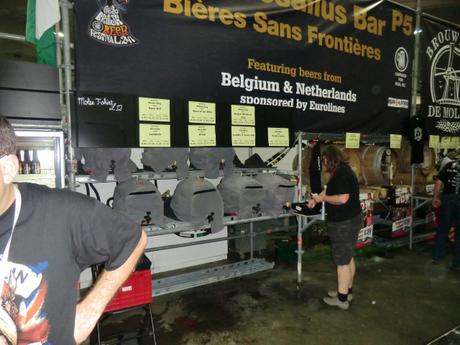
Have you ever noticed that we, the human race that is, tend to be a tribal bunch? Frankly, as statements go I would hope that to be pretty uncontroversial, yet give it time and I’m sure two sides would emerge – dug into their entrenched positions and arguing the hell out of it. Even odder the tribalism seems to be almost fractal, at every level you have smaller and smaller tribes breaking out.
Drinkers vs. Not Drinkers. Wine vs. Whisky vs. Beer. Craft Beer vs. Real Ale. Hops vs. Malt. So on and so on.
So, beer containers. They make a difference. Kegs, Casks, Cans and Bottles, plus probably others, but I’m keeping it simple(ish) here. However, for all of the fact I called this article “Container Wars” (Mainly as a geek reference to the upcoming “Combiner Wars” comics. Because I am a geek) I’d rather this not be war, more an examination of the benefits of each type.
Now I’m not a brewer, so this won’t be from the brewers side, more a set of views of someone who has drunk a hell of a lot of beers. Just a look at what seems to work better in each style – as always I happily invite feedback from people better informed than I. By necessity these sets will go by generalisations, for nearly every one I can find exceptions, but there do seem to be trends.
Casks
The old favourite, cask ale, most often hand pumped or served under gravity. For a long time cask ale was my main go to for quality ale. Well I say cask ale, cask lager is a thing, if not an overly common one. However for the most part cask and real ale are used synonymously so that is what I will be concentrating on here.
The most obvious thing with cask ales is that they have no added carbonation, and are served at cellar temperature at the coldest. Because of this I find they tend to work better with more restrained hop levels, and more malt. This isn’t hard and fast, but cask ale seems very good at having flavours last and linger on, due to texture, lack of carbonation and warmth. Hops give great flavor but large amounts tend to get sticky in a way that the other types don’t and so can wear out their welcome quicker.
The main advantage I find with cask ales is the merging of flavours, cask ales tend to allow the flavours to mix together, the malt and the hops merge when used well, each aspect influencing the others. It is a great way of holding beers that are made to be well integrated and benefit from the complexity you can get from that.
Another unique aspect is the feel, a hand pulled cask ale of any type does not feel like any other kind of beer. There can be very natural characteristics to it, a slight sourness to a bitter, slight sulphur, organic elements. In a lot of the newer style beers these can seem out of place, but used well they can create a rustic feel or can be used for contrast to the other main elements.
For these reasons, the oft maligned bitters and brown ales find a natural home, there can be a slight sourness to a bitter to make it refreshing, or a very natural blending of flavours to a brown ale which cannot be easily achieved in other ways. Even style originally foreign to the storage method, such as German inspired wheat beers can find new expressions when made with cask in mind, allowing for the extra thickness and merged flavours to create Anglo German hybrids. It is the oft overlooked choice in the new wave of brewing, but there are a lot of tricks up its sleeve. It is possibly the hardest to use though – I have seen a lot of foreign beer styles made for cask with no idea of how they will alter, resulting in lacklustre beers that seem pale imitations rather than inspired new twists. Also, cask ales need to be stored carefully, served when just right, and used quickly before they go off – at every point there is a lot that can go wrong, and cask ale with a yeast infection excessive acidity seems an ever present risk in bars without the knowledge on how to handle them.
Kegs
For years the maligned cousin of cask, now keg is standing up on its own two feet here in the UK, inspired by the USA craft beers the keg has become the beloved choice of much of the new wave of brewing in the past few years.
Kegs tend to produce sharper clearer defined flavours, there is little of the merging that you see with cask, instead each element seems to stand by itself. This can be great for where you want each element to stand alone, but not if you want the elements to complement each other more closely. Most tellingly this can be seen with hop bitterness – in the same beer tried side by side from cask and keg, the keg beer will often seem a brasher hop punch. With stouts and dark ales the chocolate and coffee notes will be clearer. This is not to say that keg ales cannot be complex, far from it, but there is less intermingling between elements, you can often sense where the malt ends and the hops begins far more easily.
As indicated before, the chilled character and carbonation often allows keg ales to play with bigger flavours that would become overwhelming in cask. This is part of the reason, I feel, why IPA beers are so popular in keg. That and they rock. Of course keg beers play a big part around the world, and a lot of beers styles around the world are native to keg and so find that as their natural habitat.
While I am concentrating on ales here, and while cask lager is a thing, I would be remiss in not pointing out that for most of the world keg is the native home of lagers – that the carbonation works to make the crisp refreshing beers that have far more flavours that the bland mass market examples back home are shamed by. Experience in Prague tells me similarly that the bottled and keg lagers show very different characteristics, which deserve to be examined, but I do not feel qualified to do so at this point. Also, while non pasturised and unfiltered beers is required for casks ales, some keg ales also can non pasturised and unfiltered, and generally are superior like that – though I have not done enough exact comparisons to say exactly what differences are, just that they tend to be cloudier and fuller flavoured.
While not as complex to keep as casks, kegs have their own quirks. Carbonation is one such issue, many pubs that are unused to craft ales seem to over carbonate their beers, resulting in Fosters like soda stream effects. In American various pubs even boasted about the exact gas mix in their carbonation – not something I could speak on myself, but you can tell a distinct difference between a well carbonated and overly carbonated beer.

Bottles
Bottles, or as I call it – 90% of the home drinking selection (though probably not market which I’m guessing may be dominated by cans). Real ale in a bottle is a thing here in the UK, and of the two take home containers I’m guessing only bottles could handle that. I would guess it is do to the fermentation in the bottle, which would not work well in a canned container. As of such the bottle market is the place to be for your real ales you would otherwise encounter in casks.
However they are definitely not just cask ales – for better and worse. Let’s face it, Trappist ales, Hefeweissens, Lambics and IPAs all come bottled, some with bottle fermentation, some without.
I think that opportunity for secondary fermentation is possibly its biggest advantage though, unique to bottles, and bottles can also be sized up – with larger bottles allegedly being better for some long term cellaring. Bottles do seem to be the go to for beers to be aged.
What happens to a beer when bottled depends on what it would otherwise be – real ale styled seem to come through smoother than their cask brothers, which can benefit some ales – they tend to have that smooth intermingled flavours, but just a touch better defined, and a lot of the beers with a wide range of hops and malts in the ingredients seem more easy to express in the bottled versions, where the cask versions can seem muddy as they try and mix too many elements. Bristol Beer Factory’s Vintage Ales are a good example of this – the wide range of elements used really don’t come through in cask, but are much better defined in bottle, without losing the ability of malt and hops to merge and benefit each other. Bottles do lose that unique feel and flavours that seem to come with cask though.
Beers that would come from keg instead tend to lose that freshness, but at the trade off of controlled carbonation levels. In each case it seems to be a compromise between the parent containers. I would say that keg oriented beers in bottles seem to differ less than their cask counterparts, hewing more closely to the parent container.
Even this is a very incomplete description. Bottled trappist ales often have secondary fermentation while I presume the keg versions do not, the trends of the UK beer scene does not map well to the wider world. However it is the beer scene within which I am most familiar, so I hope you will forgive the somewhat UKcentric view of this piece. Perhaps after more beer traveling I may return with more views of the fine beers from around the world and how they compare.
Cans
Cans were, for a long time, considered lowest of the low. Real ales that got mutilated for cans were nearly always crap. The canned lager availability was also poor. So we thought cans were the issue, not the beer that was in them.
We were, of course, wrong.
Cans have turned out as the take home younger sibling of the keg era, the recyclable metal container of the craft beer wave. The keg is therefore most definitely the closest cousin for flavor comparisons. They have similar more distinct clear elements, as of all the containers I’m guessing this would handle fermentation in the container worse. I’m not sure it is currently possible with cans. I could be wrong, but I feel their entirely sealed nature would be a pressure nightmare for additional fermentation. However this sealed nature is also cans advantage. No light, less ways for the beer to spoil. Hopped beers are preserved very crisply in cans, which is what has made them beloved of the craft scene.
So IPAs, APAs and the like come out very similarly to kegs with the can diversions, very crisp hops, very clear defined flavours. Stouts and the like don’t seem that different, and possibly psychosomaticly the bottle versions seem to be more complex. Pale beers seem to be the cans friends and their raison d’etre. They are, however, the least well examined so far of the four so I have a lot to learn on them.
Growler
You may notice I am studiously ignoring growlers up to this point, but before I go they do deserve a slight mention. Just starting to show up on the UK for the past few years, they have been a solid entry in the USA for a long time. The thing is, for flavour, they seem the weakest entry to me. As soon as they are filled you have a risk of air contact (newer technology seems to be working on this issue) – If you drink over the next few days it should not be an issue, but in every case, you are taking keg or cask beer and adding an additional element of potential infection. On the other hand they are the only way to get those beers home with you, so they have a place – but you will never get an equivalent or better experience than a fresh pulled pint.
Final Thoughts
No you can’t carry beer in thoughts. Yet. I am working on it. Though there is an argument that the beer only truly exists in our mind, so maybe, anyway I digress. Any thoughts? I’m sure many of us have had different experiences, and those of you with a bit more hands experience on the production side can add a lot. let me know what you think, and until next time…
– Enjoy your beer!

